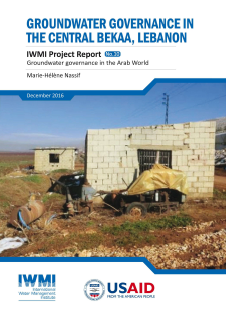Groundwater governance in the central Bekaa Lebanon
 |
rapport coll. IWMI Project Report n° 10 Dec 2016 ; 129 pages
Aut. Marie-Hélène Nassif
Ed. IWMI - Giza USAID - Antelias
Téléchargeable sous format: PdF
Téléchargeable chez l'éditeur
Abstract:
The present research focuses on the drivers of groundwater use and the impact of groundwater overexploitation on users. It takes a limited geographic area of the Upper Litani River Basin identified with an important water table drawdown. It traces back the evolution of groundwater use in space and time since the 1960s, with a focus on irrigation supply based on interviews with farmers, mayors and municipal officials and other informants, as well as on a literature review, compilation of well data and direct field observations. It also looks at the institutional framework of groundwater management and its problems based on a literature review and interviews with state officials. The unpacking of drivers and impacts of groundwater overexploitation in each of the seven studied subareas in the study zone revealed clear interrelations, both between the users of the same sub-area and between users of the different sub-areas: This creates a complex system of interrelated water uses, where reducing groundwater overexploitation and balancing its negative impacts among the different users requires the integrated understanding and management of surface and groundwater resources. Looking at the management strategies developed by users on the one hand, and by the different water authorities on the other, reveals many obstacles to establishing and enforcing appropriate and coordinated allocations from both surface and groundwater. This reveals that substantial challenges pertaining to water planning are to be faced by the state in the upcoming years. Contents:
1 Introduction
2. The general state of groundwater resources in the ULRB
2.1. Water supply on the Upper Litani River Basin
2.2. The importance of groundwater in the history of water supply in the Bekaa
2.3. Hydrogeology, geographic distribution of wells, and drawdown of water tables
3. Research objectives, presentation of case study and methodology
3.1. The importance of unpacking groundwater governance for the general water planning of the ULRB
3.2. Presentation of the study area
3.3. Methodology
3.4. Water authority and water rights
3.5. Agriculture practices
4. The evolution of groundwater use since the 1950s: Spatial heterogeneity and interrelated impacts
4.1. Hala Yahfoufa sub-area
4.2. Litani-Fourzol sub-area
4.3. Litani- Maallaqa sub-area
4.4. Litani-Barr Elias sub-area
4.5. Ghozayel sub-area
4.6. Anjar-Chamsine sub-area
4.7. Eocene sub-area
5. Unpacking the complexity of groundwater governance
5.1. The difficulty of collective water management at the level of users
5.2. The difficulty of groundwater management at the level of the state
6. Conclusions
Public-Cible:
Mots clefs: |
aspects institutionnels (CI) (DT) (OP) (ope) , irrigation (CI) (DT) (OP) (ope) |
Pays concerné: |
Editeurs/Diffuseurs: |
|
IWMI
-
International Water Management Institute - Giza - Egypte |
USAID
-
US Agency for International Development - Antelias - Liban |
En cas de lien brisé, nous le mentionner à communication@pseau.org